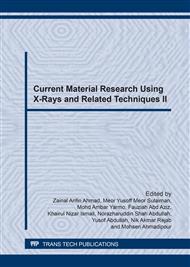p.23
p.28
p.33
p.37
p.42
p.47
p.52
p.57
p.62
Effect of Sintering Temperature on Structure and Dielectric Properties of Lead Free K0.5Na0.5NbO3 Prepared via Hot Isostatic Pressing
Abstract:
In this research, alkaline niobate known as K0.5Na0.5NbO3 (KNN) lead-free piezoelectric ceramic was synthesis by solid state reaction method which pressing at different sintering temperatures (1000 °C and 1080 °C) prepared via hot isostatic pressing (HIP)). The effect of sintering temperature on structure and dielectric properties was studied. The optimum sintering temperature (at 1080 °C for 30 minutes) using hot isostatic pressing (HIP) was successfully increase the density, enlarge the particle grain size in the range of 0.3 µm – 2.5 µm and improves the dielectric properties of K0.5Na0.5NbO3 ceramics. The larger grain size and higher density ceramics body will contribute the good dielectric properties. At room temperature, the excellent relative permittivity and tangent loss recorded at 1 MHz (ɛr = 5517.35 and tan δ = 0.954), respectively for KNN1080HIP sample. The KNN1080HIP sample is also exhibits highest relative density which is 4.485 g/cm3. The ɛr depends upon density and in this work, the density increase as the sintering temperature increase, which resulting the corresponding ɛr value also increases.
Info:
Periodical:
Pages:
42-46
Citation:
Online since:
March 2017
Price:
Сopyright:
© 2017 Trans Tech Publications Ltd. All Rights Reserved
Share:
Citation:


